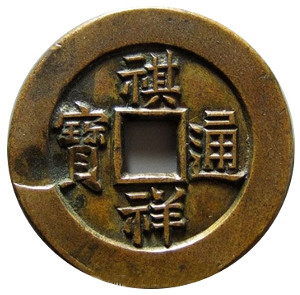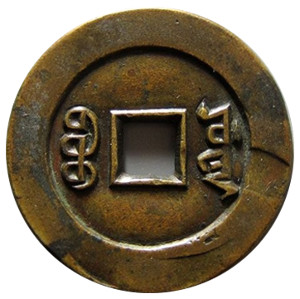A very rare qi xiang tong bao (祺祥通宝) engraved mother coin (雕母) was recently auctioned in Beijing.
The Qixiang coins were cast for the shortest period of time and in the smallest quantity of any reign of the Qing Dynasty.
Upon the death of the Xianfeng Emperor (咸丰帝) in 1861, his young son Zaichun (载淳) became the new emperor of China adopting the regnal name of Qixiang (祺祥).
The new emperor was only five years old at the time. His mother, the Empress Dowager Cixi (慈禧太后), arranged a coup (祺祥政变) and became the real power behind the throne.
After just a couple of months, the Empress Dowager Cixi changed the emperor’s regnal name from Qixiang (祺祥) to Tongzhi (同治).
Because the reign title Qixiang existed for only 69 days, very few coins with the inscription qi xiang (祺祥) were produced. It is quite possible that none of the coins ever went into general circulation.
When preparing to cast coins for a new emperor, a mint would first engrave a coin out of fine brass. This “engraved mother coin” (diao mu 雕母), also known as an “ancestor coin” (zu qian 祖钱), was then used to make impressions in a sand mold to produce several “mother coins” (mu qian 母钱). These “mother coins” were then used to make the impressions to cast the coins which would go into circulation.

Qi Xiang Tong Bao Engraved Mother Coin
The image at the left is the obverse side of the engraved mother coin.
The coin is made of high quality brass and has a beautiful patina.
The Chinese characters are finely and deeply inscribed.
However, the left rim is clearly damaged.
This was done intentionally at the mint in order to ensure that no additional coins were cast after the regnal name Qixiang was dropped in favor of Tongzhi.
This damage provides further proof that the coin is authentic.

Reverse side of Qi Xiang Tong Bao Engraved Mother Coin
The reverse side of the coin is seen in the image at the left.
The Manchu script at the right of the square hole indicates that the coin was made at the Board of Works (宝源) mint in Beijing.
The mint intentionally damaged the right rim to prevent any further use of this mother coin.
The coin has a diameter of 29.14~29.52 mm and a thickness of 1.82~2.03 mm. The weight is not mentioned in the description.
In addition to the qi xiang tong bao coins, larger “Value Ten” (当十) denomination qi xiang zhong bao (祺祥重宝) coins were also minted.
A qi xiang zhong bao (祺祥重宝) “engraved mother coin” produced at the Board of Works (宝源) may be seen here.
A qi xiang zhong bao (祺祥重宝) “mother coin” from the Board of Works (宝源) may be seen here.
Because qi xiang coins were cast for such a short time, only a few of the mints produced coins. These included the Board of Works (宝源), the Board of Revenue (宝泉), the Yunnan mint (宝云), the Gansu mint (宝巩) and the Suzhou mint (宝苏).
When the regnal name changed to Tongzhi, the mints withdrew or destroyed the qi xiang mother coins and then engraved new mother coins to produce coins with the inscription tong zhi tong bao (同治通宝) and tong zhi zhong bao (同治重宝).
All authentic qi xiang coins are rare, and qi xiang engraved mother coins are extremely rare.
Only one other specimen is known to exist. It is in the collection of Mr. Sun Zhonghui (孙仲汇), a famous Chinese numismatist and author.
On November 30, 2014, the qi xiang tong bao engraved mother coin discussed here was sold at an auction in Beijing for US$129,843 (RMB 808,500).
A fascinating, rare (and expensive!) object…